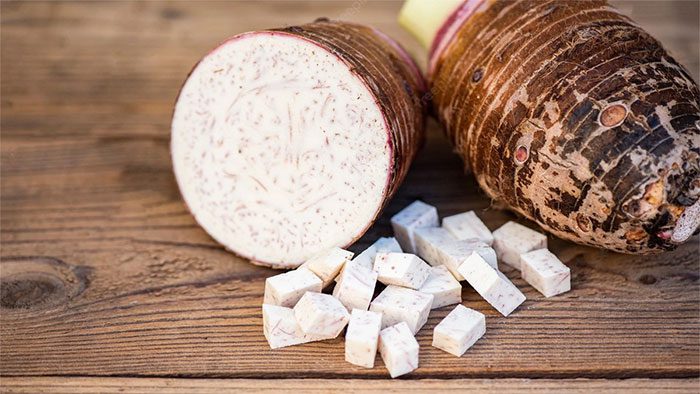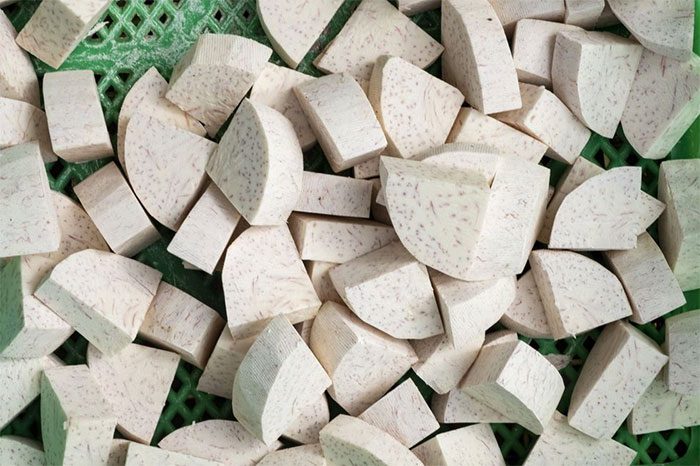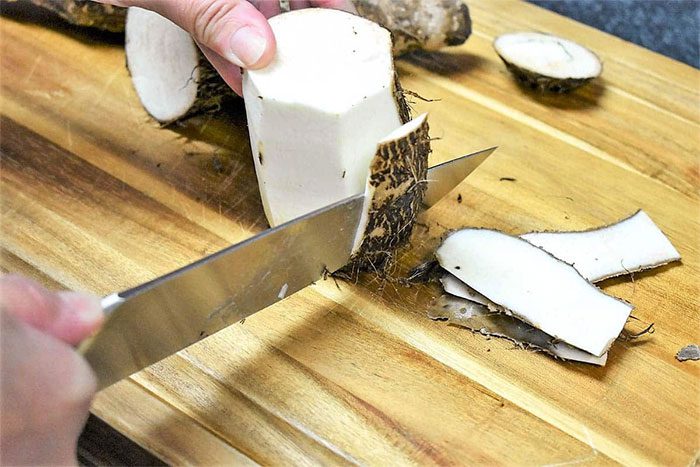If you are tired of potatoes and broccoli and are looking for a new vegetable to add to your cooking list, taro is an excellent choice.
Benefits of Taro
Taro is a widely familiar food among Southeast Asians, including Vietnamese people. It has become a staple at family meals in Vietnam, despite the stress it causes when being prepared. If not careful and if you have sensitive skin, you may experience itching after peeling it. The itching can range from mild on your hands to severe all over your body.
However, taro has a fragrant aroma, a sweet and creamy taste, and is highly nutritious, making it a popular choice among many home cooks.
According to Diana Rodriguez, a nutritionist in New York, people grow taro, also known as Xanthosoma sagittifolium, for its edible corms, which grow underground and have a texture similar to potatoes. However, taro is creamier and not as dry as potatoes.

Taro has a fragrant aroma, a sweet and creamy taste, and is highly nutritious.
Moreover, this food is also very nutritious. Taro is low in fat and sugar while being rich in fiber. People can easily recognize this tuber in various colors, from white and yellow to light purple.
Taro is highly versatile. Some people prefer to combine it with stews during the cold season or mash it to serve alongside other dishes.
Here are some reasons experts recommend including this food in your daily diet:
Taro is High in Fiber
Taro is a top choice if you are looking to increase your fiber intake. A bowl contains about 7g of fiber.
Most people know that a fiber-rich diet is highly beneficial for health, helping to reduce cholesterol and lower the risk of heart disease and many other health issues. According to the Dietary Guidelines for Americans 2020–2025, adults should consume about 25-33g of fiber daily, depending on age and gender.

Taro is nutritious, low in fat, and high in fiber.
Taro is Low in Sugar
Not only do you not have to worry about high blood sugar levels, but you also feel fuller longer when consuming taro. Many people have chosen this food as a replacement for potatoes and other high-sugar vegetables. Expert Diana states that people with diabetes or high blood sugar levels should include taro in their daily diet.
Taro is Rich in Vitamin B
Taro contains several B vitamins, including folate and riboflavin (B2). These nutrients help boost energy, support immune function, improve the health of skin, hair, nails, and can even prevent eye and heart diseases.
A deficiency in vitamin B can cause a range of symptoms such as anemia, fatigue, loss of appetite, abdominal pain, depression, numbness, tingling in hands and feet, cramps, respiratory infections, and hair loss.
Taro Provides Complex Carbohydrates
Many people avoid carbohydrates because they believe they negatively impact the body. However, carbohydrates are essential. The body needs carbs to produce glucose, which fuels energy. Taro provides a substantial amount of complex carbohydrates, offering stable energy rather than the quick bursts from simple carbs. Each bowl of taro contains up to 44g of carbs.

Taro, with its high fiber content, is also low in sugar.
Taro Offers Antioxidants
Not many people are aware that consuming taro can boost immune function. This food contains vitamin C and beta-carotene, antioxidants that can convert into vitamin A. According to expert Diana, antioxidants are essential for helping the body eliminate free radicals.
Taro is Beneficial for Blood Pressure and Heart Health
Taro has a significant amount of potassium, which is one of the essential minerals necessary for maintaining health and daily functions. Potassium facilitates fluid transport between membranes and tissues in the body and helps reduce stress and pressure on blood vessels and arteries. By relaxing veins and blood vessels, potassium helps lower blood pressure and stress on the cardiovascular system.
Promotes Weight Loss
Taro is relatively low in calories and high in cellulose, which not only enhances the feeling of fullness but also boosts the body’s metabolism and accelerates fat burning, making it suitable for those looking to lose weight.
Improves Digestive Function
The fiber content in taro can improve symptoms of acid reflux, constipation, hemorrhoids, stomach ulcers, and diverticulitis.
The resistant starch in taro is also fermented in the colon, which can increase the growth of beneficial bacteria in the gut. By increasing beneficial bacteria, the body enhances immune function and nutrient absorption.

The fiber content in taro helps improve constipation, hemorrhoids, stomach ulcers, and diverticulitis.
What to Consider When Consuming Taro?
Although nutritious, not everyone can eat it. The following individuals should avoid this food:
Allergies: Those with hives, eczema, asthma, or allergic rhinitis should consume it as little as possible, as it can cause respiratory and skin allergic reactions.
Young children: Taro is relatively slow to digest. Those with digestive issues should eat less taro, especially children with weak stomachs should pay extra attention.
Phlegm: Taro is not recommended for those with phlegm. This is because it contains a lot of taro juice, and those with phlegm often consume it, which can easily increase phlegm levels in the body and hinder recovery from illness.
Taro can be easily consumed after being cooked. However, those with hyperkalemia may experience symptoms such as arrhythmia, muscle weakness, and fatigue after eating. Therefore, if you belong to this group, you should limit or avoid consuming taro. Overall, a healthy diet always comes with the principle of “moderation,” so do not overindulge in this tuber.
As mentioned, taro is extremely versatile, allowing for various cooking methods, including roasting, frying, mashing, stewing, or adding to soups.


















































